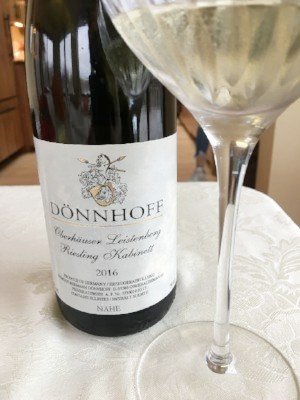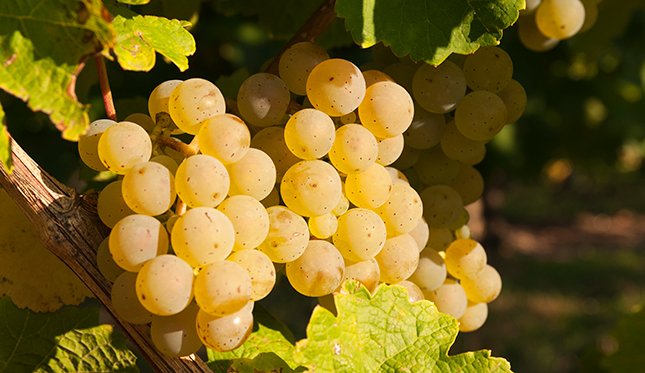
DÖNNHOFF | Oberhäuser Leistenberg
Riesling Kabinett 2016
(Nahe, Germany) $22
 Winter is a cook’s season. On a cold Saturday, content hours in a warm kitchen making something that will simmer or roast all afternoon. I believe that to cook well, one has to drink wine at the same time—for flavor inspiration. The best “cooking wines” are bright, vivid, pure, thrillingly light and low in alcohol, like this exquisite Dönnhoff riesling. It’s a wave of delicious energy. It virtually vibrates with crystalline freshness. Dönnhoff is one of Germany’s finest artisanal producers. Their filigreed rieslings are wine as inspiration. (9% abv)
Winter is a cook’s season. On a cold Saturday, content hours in a warm kitchen making something that will simmer or roast all afternoon. I believe that to cook well, one has to drink wine at the same time—for flavor inspiration. The best “cooking wines” are bright, vivid, pure, thrillingly light and low in alcohol, like this exquisite Dönnhoff riesling. It’s a wave of delicious energy. It virtually vibrates with crystalline freshness. Dönnhoff is one of Germany’s finest artisanal producers. Their filigreed rieslings are wine as inspiration. (9% abv)
92 points KM
Available at Vinopolis

What is scuppernong?
A. The plastic material that barrel bungs are made from
B. A local South African name for chenin blanc
C. A vine disease that can affect grapevines that have been exposed to extreme heat
D. A grape native to the American south
Scroll down for the answer!

Partying Pre-Mescal
We just heard from the af&co 2018 Trends Report that mescal cocktails will be one of next year’s hot items. That got us to thinking about what people drank in the Americas before the arrival of the Spanish conquistadores in the 16th century. It wasn’t an alcoholic beverage made from grapes. Instead, the indigenous peoples of Meso-America made alcoholic drinks such as pulque (the forerunner of mescal), from the maguey or agave plant; tesgüino from the sprouted kernels of maize; and balche from mead, flavored with the leaves of the Lonchocarpus, a tropical climbing shrub with colorful flowers. What makes this all the more fascinating is that numerous native grape species were to be found in the Americas, including in northern Mexico and the Rio Grande Valley of Texas.


“Too much of anything is bad, but too much Champagne is just right.”

Cooperage
Cooperage is the general term for containers used to store wine. Small barrels, large wooden casks, and stainless steel tanks are the most common kinds of cooperage, but containers made from concrete, fiberglass, and glass are also employed. In California, one of the newest forms of cooperage are concrete eggs, which have been used by high-end wineries for a decade.

A story—50+ Years Old—Revealed
Wine is connection. It’s a bridge to friendship, sometimes in the most improbable ways. Like the November 17 edition of WineSpeed that brought together two respected men in the wine industry, who discovered a special shared history—all because of the Wine Question. Here are excerpts from their email exchange, which I reprint with their permission. But first, a reminder of that question it asked: Continue Reading…

“It seems like zinfandel wines are usually high in alcohol. Why is this?”
—Michael Z., Dallas, TX
Hi, Michael. Good question. Zinfandel has a genetic proclivity to ripen unevenly. That means that on the same cluster, there will be perfectly ripe grapes, under-ripe grapes, and some grapes that are so ripe they’re virtually raisins. If a winemaker picks grape clusters like this, there’s a good chance that the wine will taste weird–both unripe and overripe at the same time. To avoid this, most winemakers let zinfandel hang on the vine until the unripe grapes have become perfectly ripe; at which point, many of the other grapes have turned overly ripe. Then, during fermentation, the yeasts convert the abundant sweetness of the overripe grapes into considerable alcohol. The result is that many zinfandels can’t help being a bit high in alcohol.


D. Scuppernong grapes are extremely large, round, greenish-bronze grapes that belong to the North American species Vitis rotundifolia, also known as the muscadine species. The name comes from the Scuppernong River in North Carolina, along which the grapes once grew profusely. Scuppernong grapes are, in fact, the state’s official fruit. They were first cultivated in the 17th century. Today, home winemakers in the South often use scuppernongs, although many consider the grapes better-suited to jelly than wine.
SaveSave








